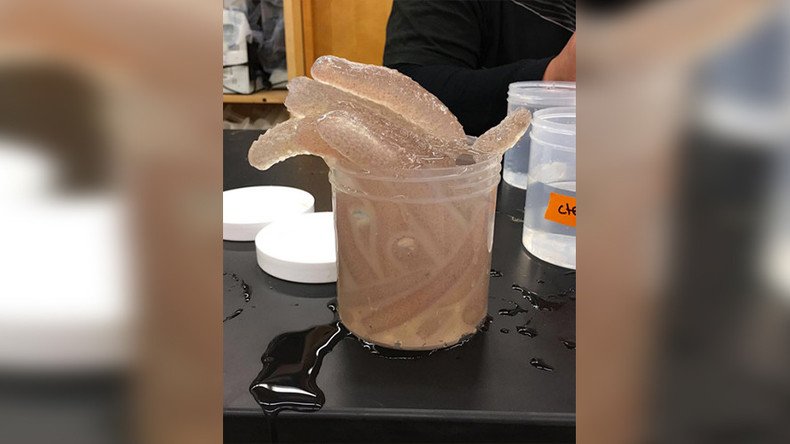Bizarre asexual, glow-in-the-dark sea creatures invade Pacific (VIDEOS, PHOTOS)

A party of pyrosomes invading the Pacific is causing great concern that the non-native creature could damage the area's food chain. Millions of the translucent, cucumber-shaped species have been spotted much further north than their usual haunts.
#ONCabyss Upper water column is full of Pyrosomes pic.twitter.com/2924OnMRko
— Paul Macoun (@PaulMacoun) June 17, 2017
Typically found in the Tropics, pyrosomes - meaning ‘fire bodies’ due to their bioluminescence - have been spotted in the waters off Alaska and British Columbia. One fisherman told National Geographic that when he dragged up 50 fishing hooks they were on almost every one.
"It got to the point where they couldn't effectively fish," Leon Shaul of the Alaska Department of Fish and Game said.
In Oregon a research team managed to gather 60,000 of the creatures in just five minutes during a trawl, reported CBC.
Typically found in the tropics, we're seeing huge numbers of #pyrosomes in the eastern Pacific. Read more https://t.co/pZ8aQHhc2A#ONCabysspic.twitter.com/18RnlIJWmW
— Ocean Networks 🇨🇦 (@Ocean_Networks) June 14, 2017
In British Columbia they’ve been measured between 8 and 60cm in length, much smaller than their potential growth length of 10 meters in warmer waters.
"Right now, these are only visitors, not an invasive species, yet," Moira Galbraith from the Institute of Ocean Sciences told CBC. "They are here for now, until the currents take them elsewhere."
Galbraith believes unusually warm currents brought the creatures to the area between 2014 and 2016, along with warm-water sharks and sea snakes that bizarrely appeared along the coast of California. Unlike the sharks and snakes though, the pyrosomes stuck around and multiplied when the waters cooled down.
This week, we've been dazzled by flurries of pyrosomes (gelatinous colonial tunicates) as ROV Hercules ascends to the surface! #ONCAbysspic.twitter.com/N4UQMBEcdH
— E/V Nautilus (@EVNautilus) June 14, 2017
Each pyrosome consists of thousands of smaller individual pyrosomes embedded in a gelatinous tunic with the ability to reproduce asexually and sexually, allowing them to rapidly create giant swarms.
What is a pyrosome & why are they blooming off Pacific NW coast? https://t.co/83ekZDjmr3@NatGeo@CraigAWelch@NOAAFish_NWFSCpic.twitter.com/73EsD5I99N
— NOAA Fish media team (@NOAAFishMedia) June 14, 2017
Although not poisonous, the creature poses a problem for fishermen who are faced with a season of plucking thousands of them from their nets. Scientists are unsure what effect they may have on fish stocks, which could potentially become starved of plankton from the huge swarms of pyrosomes.
Another worry is that the vast size of the swarms could deplete the water of huge amounts of oxygen when they finally die and decompose.












